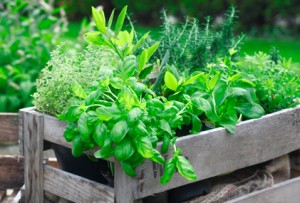 Herbs are some of the easiest, most versatile and useful plants to grow. If you’re going to start a garden for the first time, try growing herbs. Many of them grow with very little care, and if you live in a condominium or townhome with limited space, herbs can easily be grown in containers. Whether you’ve got acres of land or just a few pots on a patio, here are a few tips for growing a successful herb garden.
Herbs are some of the easiest, most versatile and useful plants to grow. If you’re going to start a garden for the first time, try growing herbs. Many of them grow with very little care, and if you live in a condominium or townhome with limited space, herbs can easily be grown in containers. Whether you’ve got acres of land or just a few pots on a patio, here are a few tips for growing a successful herb garden.
Tip #1: Grow Herbs You’ll Eat
There’s no sense in growing herbs you won’t eat. Do you enjoy a nice caprese salad of tomatoes, mozzarella, and basil? Do you like your mojito with plenty of mint? What about pan-fried potatoes with garlic and rosemary, or lentils simmered in broth with a few thyme sprigs? Think about your favorite recipes. List the herbs used in each, and grow the herbs you will eat.
Tip #2: Prepare the Soil to Grow Your Herb Garden
Although most herbs will tolerate dry, rocky soils, it is best to grow herbs in a dark, crumbly, fertile soil that has plenty of organic matter and good drainage. One of the best tips for growing an herb garden is to work in plenty of compost, worm castings, and fertilizer before planting. By preparing the soil, you’ll give your herb garden the best possible chances for success.
Tip #3: Understand Each Herb’s Need for Water
Many herbs, such as bay and lemon balm, produce the most intense flavors in poor, dry soils. However, each herb is different. Some herbs, like mint and catnip, for example, grow best in moist soils. Novice gardeners often think that more water is better. If a plant looks like it’s struggling, just add water, right? Unfortunately, no. Each herb has different needs for water, and if you water some herbs too much, you will cause them to rot at the roots and die. Most garden plants need an average of one inch of water per week. Some will need more, some less. If you take the time to research the herbs you’re going to grow, you’ll know where you need more or less water.
Tip #4: Group Herbs with Similar Growing Requirements
Once you have a list of herbs you wish to plant in your herb garden, sort through the list and group them according to their sunlight and water needs. Plant the herbs that need a dry, sunny site in an appropriate area of the garden, and group the herbs that need moist, shady sites in an area with the proper conditions. This will give the herbs the light they need and make watering easier.
In a sunny site you might plant basil, chives, oregano, dill, rosemary, sage, tarragon, and thyme. In a shady site, try planting any of the mints, wild ginger, nettle, parsley, catnip, sweet cicely, and monarda.
Tip #5: Create a Garden Design That Works With Your Style
Herbs have been cultivated for thousands of years, as far back as ancient Egypt and ancient Rome, in monastery cloisters, knot gardens, and parterres. They can be as simple or complex as you want to make them. If you only have a tiny space on a patio, use a strawberry pot and plant each pocket with a different herb. In a grouping of pots, you can plant several herbs and easily grow the most common herbs used in cooking. If you have a townhouse and are limited to a small planting bed area, nestle a few herbs among shrubs and perennials. These informal solutions are great for small spaces.
If you have more space, you can create an herb garden that is as formal or informal as you like. If formal is your style, consider a classic knot garden design. The layout can be a square, rectangle or symmetrical arrangement of geometrical shapes with low, clipped herb borders and straight lines. Lavender and tightly clipped box hedges can serve as borders, and bay trees can be clipped into topiary shapes.
No matter what your style, you can grow an herb garden.
